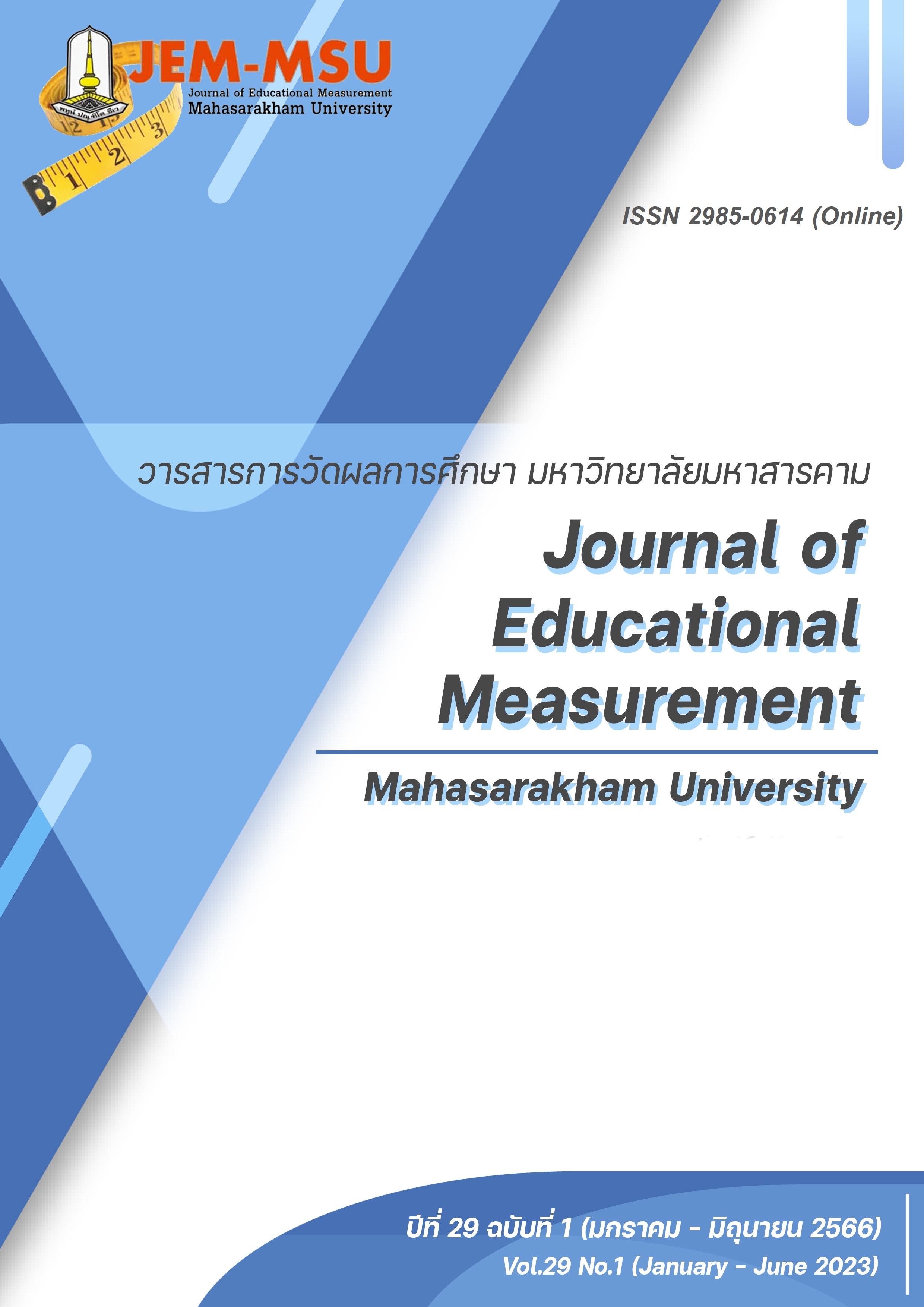การศึกษาอิทธิพลของชีวิตการทำงานที่มีต่อภาวะสุขภาพจิต และความเหนื่อยหน่ายในการทำงานของครู
Main Article Content
บทคัดย่อ
การศึกษาครั้งนี้มีความมุ่งหมายเพื่อศึกษาชีวิตการทำงาน ภาวะสุขภาพจิต และความเหนื่อยหน่าย ในการทำงาน และเพื่อศึกษาอิทธิพลของชีวิตการทำงานที่มีต่อภาวะสุขภาพจิตและความเหนื่อยหน่ายของครู ตัวอย่างในการศึกษาครั้งนี้เป็นครูในโรงเรียนประถมศึกษาและมัธยมศึกษาจำนวน 210 คนที่อาสาเข้าร่วมตอบแบบสอบถามออนไลน์ เครื่องมือในการวิจัย ได้แก่ แบบประเมินภาวะซึมเศร้า ความวิตกกังวล ความเครียด 21 (DASS-21) แบบสำรวจชีวิตการทำงาน (AWS) และ แบบประเมินความเหนื่อยหน่ายสำหรับครูของ Maslach (MBI-ES) สถิติที่ใช้ในการวิเคราะห์ข้อมูล ได้แก่ ความถี่ ค่าเฉลี่ย ส่วนเบี่ยงเบนมาตรฐาน ค่าสัมประสิทธิ์สหสัมพันธ์ของเพียร์สัน และการวิเคราะห์ถดถอยพหุคูณวิธีแบบ Stepwise ผลการวิเคราะห์ข้อมูล พบว่า ชีวิตการทำงาน 6 ด้าน มีคะแนนเฉลี่ยอยู่ในระดับปานกลางถึงมาก ภาวะสุขภาพจิตของครูด้านความเครียดและภาวะซึมเศร้าอยู่ในระดับปกติ ในขณะที่ความวิตกกังวลอยู่ในระดับสูงเล็กน้อย สำหรับความเหนื่อยหน่ายใน การทำงาน พบว่า ค่าเฉลี่ยด้านความอ่อนล้าทางอารมณ์และความเฉยชา ไม่ใส่ใจอยู่ในระดับต่ำ ในขณะที่ค่าเฉลี่ยด้านประสิทธิภาพในการทำงานอยู่ในระดับสูง ผลจากการวิเคราะห์ถดถอยพหุคูณ พบว่า ปัจจัยชีวิต การทำงานด้านการควบคุมงานและภาระงานสามารถพยากรณ์สุขภาพจิตด้านความเครียดได้ร้อยละ 19.0 ชุมชนในที่ทำงานและการควบคุมงานสามารถพยากรณ์ความวิตกกังวลได้ร้อยละ 17.5 การควบคุมงานและรางวัลสามารถร่วมทำนายภาวะซึมเศร้าได้ร้อยละ 25.4 การควบคุมงาน ความยุติธรรม ภาระงานและค่านิยมสามารถพยากรณ์ความอ่อนล้าทางอารมณ์ได้ร้อยละ 34.2 ชุมชนในที่ทำงานและค่านิยมสามารถร่วมทำนายความเฉยชา ไม่ใส่ใจได้ร้อยละ 19.5 และชุมชนในที่ทำงานและการควบคุมงานสามารถร่วมทำนายประสิทธิภาพในการทำงานได้ร้อยละ 23.4 ผลของการศึกษาครั้งนี้เป็นข้อสนเทศที่สำคัญในการตระหนักถึงความสำคัญของปัจจัยด้านการทำงานที่มีต่อสุขภาวะของครู
Article Details

อนุญาตภายใต้เงื่อนไข Creative Commons Attribution-NonCommercial-NoDerivatives 4.0 International License.
เนื้อหาและข้อมูลในบทความที่ลงตีพิมพ์ในวารสารการวัดผลการศึกษา มหาวิทยาลัยมหาสารคาม ถือเป็นข้อคิดเห็นและความรับผิดชอบของผู้เขียนบทความโดยตรง ซึ่งกองบรรณาธิการวารสาร ไม่จำเป็นต้องเห็นด้วย หรือร่วมรับผิดชอบใดๆ
บทความ ข้อมูล เนื้อหา รูปภาพ ฯลฯ ที่ได้รับการตีพิมพ์ในวารสารการวัดผลการศึกษา มหาวิทยาลัยมหาสารคาม ถือเป็นลิขสิทธิ์ของวารสารการวัดผลการศึกษา มหาวิทยาลัยมหาสารคาม หากบุคคลหรือหน่วยงานใดต้องการนำทั้งหมดหรือส่วนใดส่วนหนึ่งไปเผยแพร่ต่อหรือกระทำการใดๆ จะต้องได้รับอนุญาตเป็นลายลักษณ์อักษรจากวารสารการวัดผลการศึกษา มหาวิทยาลัยมหาสารคาม ก่อนเท่านั้น
เอกสารอ้างอิง
Baroud, T., EL Masri, J., Shammaa, H., Chanbour, H., & Salameh, P. (2021). The impact of Covid19 pandemic, financial wellness, and online teaching on Lebanese schoolteachers’ mental health. Clinical Case Reports and Clinical Study, 5(4). https://doi.org/09.2021/1.108
Berquam, J. (2020). The Relationship Between Job-Person Fit and Use of Emotional Labor in Teachers [Doctoral dissertation]. Grand Canyon University.
Carleton, R. N., Gosselin, P., & Asmundson, G. J. G. (2010). The intolerance of uncertainty index: Replication and extension with an English sample. Psychological Assessment, 22(2), 396-406. https://doi.org/10.1037/a0019230
Depression Anxiety Stress Scales. (2018). Overview of the DASS and its uses. http://www2.psy.unsw.edu.au/dass//over.htm
Hassan, O., & Ibourk, A. (2021). Burnout, self-efficacy and job satisfaction among primary school teachers in morocco. Social Sciences & Humanities Open, 4(1), 100148.
Jacoby, R. J. (2020). Intolerance of uncertainty. In Clinical handbook of fear and anxiety: Maintenance processes and treatment mechanisms (pp. 45-63). American Psychological Association.
Jones‐Rincon, A., & Howard, K. J. (2019). Anxiety in the workplace: A comprehensive occupational health evaluation of anxiety disorder in public school teachers. Journal of Applied Biobehavioral Research, 24(1), e12133.
Kabito, G. G., & Wami, S. D. (2020). Perceived work-related stress and its associated factors among public secondary school teachers in Gondar city: a cross-sectional study from Ethiopia. BMC research notes, 13(1), 1-7.
Leiter, M. P. (1999). Burnout among teachers as a crisis in psychological contracts. In Understanding and preventing teacher burnout: A sourcebook of international research and practice (pp. 202-210). Cambridge University Press.
Leiter, M. P., & Maslach, C. (2004). Areas of work life: A structured approach to organizational predictors of job burnout. In Research in occupational stress and well being: Vol. 3. Emotional and physiological processes and positive intervention strategies (pp. 91-134). Elsevier
Leiter, M. P. & Maslach, C. (2011), Areas of work life survey manual (5th Ed.). Mind Garden.
Leiter, M. P., & Maslach, C. (2016). Latent burnout profiles: A new approach to understanding the burnout experience. Burnout Research, 3(4), 89-100.
Lovibond, S. H., & Lovibond, P. F. (1995). Manual for the depression anxiety & stress scales (2nd Ed.). Psychology Foundation.
Mack, J. C., Johnson, A., Jones‐Rincon, A., Tsatenawa, V., & Howard, K. (2019). Why do teachers leave? A comprehensive occupational health study evaluating intent‐to‐quit in public school teachers. Journal of Applied Biobehavioral Research, 24(1), e12160.
Mahmoodi‐Shahrebabaki, M. (2018). Teacher burnout. The TESOL encyclopedia of English language teaching, 1-8. https://doi.org/10.1002/9781118784235.eelt0964
Maslach, C. (1999). Progress in understanding teacher burnout. In Understanding and preventing teacher burnout: A sourcebook of international research and practice (pp. 211 – 222). Cambridge University Press.
Maslach, C. (2019). A message from the Maslach Burnout Inventory Authors. Mind Garden. https://www.mindgarden.com/blog/post/44-a-message-from-the-maslach-burnout-inventory-authors
Maslach, C., Jackson, S. E., Leiter, M. P., Schaufeli, W. B., & Schwab, R. L. (2018). Maslach burnout inventory manual (4th Ed.). Mind Garden.
Maslach, C., & Leiter, M. P. (1997). The truth about burnout: How organizations cause personal stress and what to do about it. John Wiley & Sons.
Maslach, C., & Leiter, M. P. (1999). Teacher burnout: a research agenda. In Understanding and preventing teacher burnout (pp. 295-303). Cambridge University Press.
Maslach, C., Leiter, M. P., & Schaufeli, W. (2009). Measuring burnout. In The oxford handbook of organizational well-being (pp. 86-108). Oxford University Press.
Martínez-Monteagudo, M. C., Inglés, C. J., Granados, L., Aparisi, D., & García-Fernández, J. M. (2019). Trait emotional intelligence profiles, burnout, anxiety, depression, and stress in secondary education teachers. Personality and Individual Differences, 142, 53-61. https://doi.org/10.1016/j.paid.2019.01.036
Mojsa-Kaja, J., Golonka, K., & Marek, T. (2015). Job burnout and engagement among teachers – work life areas and personality traits as predictors of relationships with work. International Journal of Occupational Medicine and Environmental Health, 28(1), 102-119.
Morling, B. (2018). Research methods in psychology: Evaluating a world of information (3rd Ed.). W. W. Norton & Company.
Pikhart, H., Bobak, M., Pajak, A., Malyutina, S., Kubinova, R., Topor, R., Sebakova, H., Nikitin, Y., & Marmot, M. (2004). Psychosocial factors at work and depression in three countries of Central and Eastern Europe. Social Science & Medicine, 58(8), 1475-1482.
Ratanasiripong, P., China, T., Ratanasiripong, N. T., & Toyama, S. (2020). Resiliency and mental health of school teachers in Okinawa. Journal of Health Research. https://doi.org/10.1108/JHR-11-2019-0248
Ratanasiripong, P., Ratanasiripong, N. T., Nungdanjark, W., Thongthammarat, Y., & Toyama, S. (2021). Mental health and burnout among teachers in Thailand. Journal of Health Research. https://doi.org/10.1108/JHR-05-2020-0181
World Health Organization. (2019). Burn-out an "occupational phenomenon": International Classification of Diseases. https://www.who.int/news/item/28-05-2019-burn-out-an-occupational-phenomenon-international-classification-of-diseases
Yilmaz, K., Altinkurt, Y., Guner, M., & Sen, B. (2015). The relationship between teachers’ emotional labor and burnout level. Eurasian Journal of Educational Research, 59, 75-90. http://dx.doi.org/10.14689/ejer.2015.59.5
Phusee-orn, S. (2015). Applying SPSS for analyzing research data (7th Ed.). Taksila publishing. (in Thai)
Piyaphotchanakorn, S., Kaewkungwal, S., Sompakdee, S., & Yimsook, N. (2017). Self-efficacy, job demands-job resources and burnout with perception of organizational justice as a moderating variable. Journal of Social Work, 25(1), 91-118. (in Thai)
Ploytabtim, K., Buathong, N., Prasartpornsirichoke, J., & Chandarasiri, P. (2021). Prevalence and associated factors of anxiety and depression among teachers of one private all-girls boarding school. Journal of the Psychiatric Association of Thailand, 66(1), 25-38. (in Thai)
Tongying, C. (2016). Teacher Problems: Problems to be reformed. https://dl.parliament.go.th/backoffice/viewer2300/web/previewer.php (in Thai)


